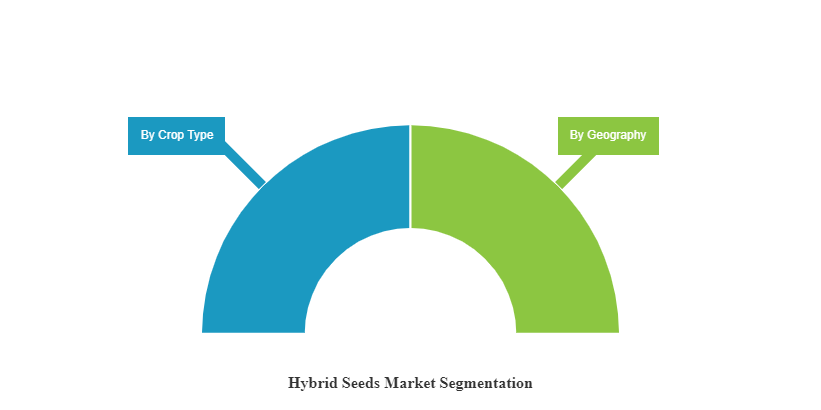Home / Agriculture / Hybrid Seeds Market
Hybrid Seeds Market Size, Share And Analysis by Crop Type(Cereals (Rice, Corn, Barley, and Sorghum), Oilseeds (Canola, Soybean, Cotton, and Sunflower), Fruits & Vegetables (Tomato, Cabbage, Chilli & Bell pepper, Okra, Cucumber, and Melons)), And Regional Forecast, 2025-2032
Report Format: PDF | Published Date: Ongoing | Report ID: FBI100526 | Status : UpcomingIncreasing population & disposable income of the people (that demand for more protein), growing urban cities, and shrinking arable land is placing significant pressure on the food supply infrastructure. Seeds are being primary input in the production of crops and other inputs are contingent upon the quality of seed for being optimally effective. Hence, good quality seed or planting material is the most critical input for the sustainability of agriculture and seeds with higher productivity will aid in attaining growing demand for agricultural produce.
Hybridization technology in improving crop attributes plays an important role in the seed industry. The technology helped in developing the various combination of characteristics such as grain/produce qualities, productivity, stability to withstand the pest incidences, etc.

Limited awareness among crop producers about the benefits of using hybrid seeds and heavy reliance on farm-saved seeds & dominance of informal seed supply chain are the key factors that affect the hybrid seed market. Low purchasing power, lack of appropriate new varieties, higher prices of hybrid seeds compared to conventional seeds (farm-saved), poor infrastructure, regulatory hurdles, high R&D costs, and reproduction and marketing of patented verities are other major inhibiting factors for the growth of hybrid seeds market.
According to FAO, the current global population stands at 7.63 billion in 2018, witnessed an average growth of 1.14% (2014-2018) and is expected to reach 8.19 billion by 2025 and 8.55 billion by 2030. The rapid rate of increase in global population and diversified demand for agricultural produce from various end-use application areas (such as feed, fuel, and fibre) is emphasizing the need for an increase in production (volume) to keep the supply-demand balance. Technological advancements such as hybrid seeds play a vital role in upholding supply-demand balance with the yield advantage over the traditional seed material.
Hybrid seeds are commercially produced by crossing two genetically dissimilar parents. The primary value of hybrid seeds lays in a lower grain production cost and reduced land requirements as compared to growing conventional varietal seeds.
Key Players Covered
Few large companies are recognized as key players in the seed industry while the majority of the private companies tend to concentrate on profitable crops, especially those in which hybrids exist. The level of concentration has strongly increased in the seed industry over the last few decades and is increasing more rapidly. The multinational companies have managed to dominate a large part of the hybrid seed market mainly by the acquisition of other seed companies. Increased merge & acquisitions in the seed industry is projected to increase the efficiency of organizations and synergy in R&D and innovations to meet the growing global demand for crop produce.
Some of the major companies that are present in the global hybrid seed market are Monsanto, DowDuPont, Syngenta, Groupe Limagrain, Land O’ Lakes, KWS, Bayer CropScience, Sakata, DLF, and others.
SEGMENTATION
SEGMENTATION | DETAILS |
By Crop Type | · Cereals (Rice, Corn, Barley, and Sorghum) · Oilseeds (Canola, Soybean, Cotton, and Sunflower) · Fruits & Vegetables (Tomato, Cabbage, Chilli & Bell pepper, Okra, Cucumber, and Melons) · Other Crops |
By Geography | · North America (USA, Canada, and Mexico) · Europe (France, Germany, Italy, Spain, U.K., Russia, and Rest of Europe) · Asia Pacific (China, India, Japan, Indonesia, Vietnam, and Rest of Asia Pacific) · South America (Brazil, Argentina, and Rest of South America) · Middle East & Africa (South Africa and Rest of MEA) |
Cereals and oilseeds segment accounts for the large share in the global hybrid seed market due to large cultivation area under these crops across the world. Rice and corn are the largest commercially grown crops and account for major market share within the cereals hybrid seeds segment. Short duration hybrid seeds have gained higher importance considering the various benefits associated in the cultivation of these.
Regional Analysis
North America region dominated the market for hybrid seeds and is expected to account for a significant proportion of the market in the forecast period as well. The Asia Pacific and Latin America are projected to witness strong growth for the hybrid seeds market during the forecast period. Countries such as U.K., U.S., The Netherlands, and China are the key exporters of (in terms of volume) vegetable crop seeds globally.
Key Industry Developments
- In August 2018, BASF closed the acquisition of Bayer’s global vegetable seeds business, mainly operating under the brand Nunhems. The acquired vegetable seeds business comprises 24 crops and about 2,600 varieties.
- In November 2018, BASF has opened a new state-of-the-art breeding center for cucumbers at its site in Nunhem. The facility will increase BASF’s capabilities to meet the needs of consumers and the global food value chain with novel vegetable varieties.
- Global
- 2023
- 2019-2022


